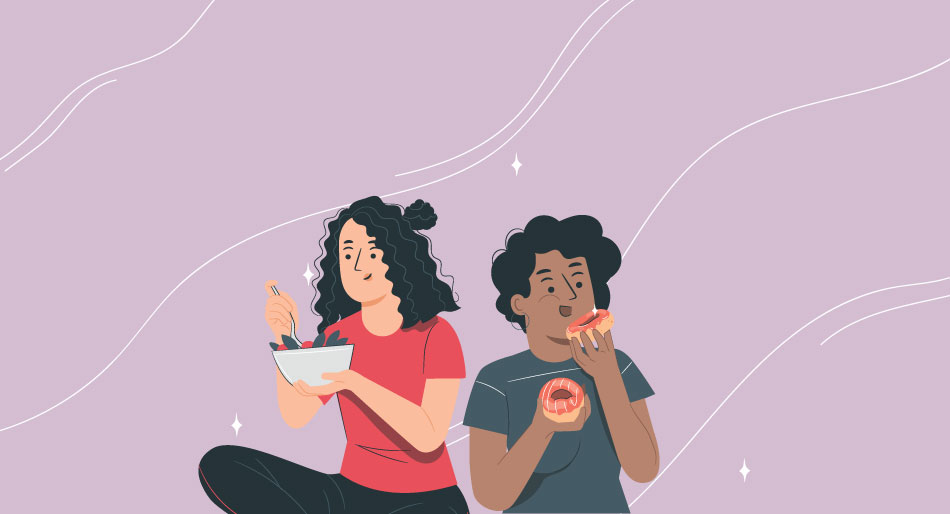
To eat or not to eat? – Everything about eating disorders

"Sorry, there's no magic bullet. You gotta eat healthy and live healthy to be healthy and look healthy. End of story."
― Morgan Spurlock
We all wake up to these motivational quotes about health and life. However, our Ids and superegos rarely agree.
Did you guys break up? Don't worry; eat a tub full of ice cream.
You're free tonight? Let's order a pizza and watch something on Netflix.
Well, food has an association with the feeling of comfort and being at home. So, what we eat and what we don’t want to eat are also associated with our thoughts and emotions.
Hence eating problems such as less appetite cannot be labeled as eating disorders. According to American Psychiatric Association, “Eating disorders are behavioral conditions characterized by severe and persistent disturbance in eating behaviors and associated distressing thoughts and emotions.”
Though eating disorders seem to be more prevalent in western countries, it is only the lack of research and documentation in India.
What causes eating disorders? Is there any one factor that can be blamed?
No. It is caused by the interplay of various factors such as biological, psychological, and environmental. Biological factors include the presence of certain genes which put them at a higher risk of eating disorders. Psychological factors include anxiety , depression , and other disorders causing appetite disturbances or eating problems. Social media and peer pressure also contribute to it.
So, let us know in detail exactly what happens with eating disorders.
There are different types of eating disorders namely
- anorexia nervosa,
- bulimia,
- binge eating disorder,
- pica,
- rumination disorder
- avoidant/restrictive food intake and
- Night eating syndrome
Anorexia & Bulimia eating disorder-
Those with anorexia or bulimia may be trapped in these abnormal behaviors as a need to be validated by their parents or peers. Social media influencers have also been a huge factor that directs adolescents towards anorexia or bulimia along with body dysmorphia. The patients suffering from these two disorders have a faulty self-image . Though they are medically overweight, they think of themselves as obese.
Another disorder that is similar to bulimia is purging disorder where the individual intentionally vomits without binging.
Binge eating disorder-
Food has been serving more purposes such as numbing emotions and distracting yourself from uncomfortable emotions or feelings rather than just filling your stomach. With the increased accessibility, the rise of junk food joints, food vlogs, and strange food trends, binge eating has been more prevalent among Gen-Z. It is also known as stress eating. Binge eating is also a call for help. It can be a self-soothing activity to fulfill a child's need to be loved or to be paid attention to.
Pica eating disorder-
It is an eating disorder that one can see commonly in children belonging to lower socio-economic backgrounds. They chew on chalks, erasers, whiteners, lead from pencils, and even paper. Even some of us have eaten chalk in our childhood and our mothers have blamed it on a lack of calcium.
There have also been cases of addiction to cough syrup. However, it can occur in all age groups. Research studies show its higher frequency in those with developmental conditions such as
- autism spectrum disorder,
- intellectual disabilities, and
- mental health conditions such as schizophrenia .
Individuals with pica may lack nutrition and are at higher risk of injury and poisoning.
Rumination eating disorder-
Rumination is a condition in which an individual regurgitates food they have chewed and swallowed before, re-chews it, and then either re-swallows it or spits it out. The intent of doing so is to keep feeling full while having less amount of food.
Avoidant/restrictive food intake-
Earlier it was known as a feeding disorder for early and infant childhood. It involves disturbed eating due to either a lack of interest in eating or a distaste for certain temperatures, colors, textures, tastes, or smells.
Night eating syndrome-
It involves excessive food intake by individuals at night after waking up from sleep.
Though these disorders occur in all age groups, they are more prevalent in females than males due to high societal expectations from females to look beautiful and perfect. These expectations are loaded by parents and society once the girl is of marriageable age. However, these days, we can see eating disorders among people from 10 to 12 years of age group as well. The race for unrealistic perfection and flawless beauty among these young girls is scary. Progressive AI technology, potentially for the development and upliftment of our society is making unreal beauty standards achievable for them. It attracts unwanted attention from predators and pedophiles.
Even the apps have forgotten their ethics with the intent of increasing engagement. Tiktoks and reels, once a source of entertainment, have meddled with their lifestyles. Gym culture has also pressurized the males to have the ideal six-packs.
Here comes the need for proper counseling. But mental health care in India has just begun to grow with increasing awareness post covid. All kinds of eating disorders are fatal, hence, in case of serious issues, immediate admission to the hospital and medications become mandatory. However, in the early stages, an eclectic therapy approach can be highly effective.
It becomes important for various educational as well as work institutions to make their spaces unconditional and body-positive. Only then will it be more likely for someone suffering from an eating disorder to ask for help.
However, just like charity, mental and physical wellness begins at home. So, let us teach our sons and daughters and peers that,
A fit, healthy body—that is the best fashion statement
Jess C Scott
Image credits: Freepik

How Psychotherapy Helps in Late-Life Depression And Anxiety: A Path to Healing, Hope, And Healthy Aging
How Social Isolation Impacts Geriatric Mental Health? How to Reverse It?

